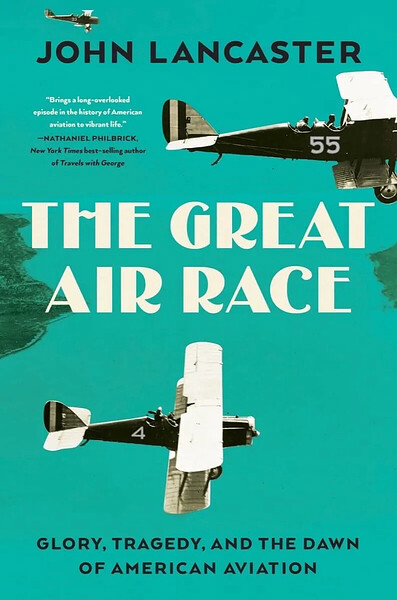Looking for a good read? Here is a recommendation. I have an unusual approach to reviewing books. I review books I feel merit a review. Each review is an opportunity to recommend a book. If I do not think a book is worth reading, I find another book to review. You do not have to agree with everything every author has written (I do not), but the fiction I review is entertaining (and often thought-provoking) and the non-fiction contain ideas worth reading.
Book Review
Marvelous Adventure Story Recounts Forgotten 1919 Transcontinental Air Race
Reviewed by Mark Lardas
June 4, 2023
“The Great Air Race: Death, Glory, and the Dawn of American Aviation,” by John Lancaster, Liveright, 2022, 368 pages, $28.95 (Hardcover), $14.99 (Ebook)
In 1903 America led the world in aviation. By 1919 the United States aviation industry lagged other nations. Europe was begin commercial airlines. In the much-larger United States aviation was seemingly limited to aerial entertainment. Americans appeared to be losing interest in aviation.
“The Great Air Race: Death, Glory, and the Dawn of American Aviation,” by John Lancaster recounts an almost forgotten 1919 transcontinental air race. Hosted by the Army Air Service and limited to military pilots, it was billed as a demonstration of capability, not a race. It attempted to revive the America’s aviation industry.
The 1919 Aircraft Reliability Race was the brainchild of Brigadier General William “Billy” Mitchell, then America’s foremost air power advocate. In 1919 he was at the height of his influence. A war hero and Director of Military Aeronautics, Mitchell organized it as a readiness demonstration. Army pilots starting in New York City and San Francisco, would cross the continent to the other city and then fly back to their origin. Half would start in each city. It was not a “race,” although the competitive instincts of the participants made it one. The pilot completing the journey first would have bragging rights.
For Mitchell the goal was to create a transportation infrastructure, inducing cities along the path to set up airfields to support the race. These, he hoped, would fuel commercial aviation. There were no municipal airports because there was almost no commercial aviation and no commercial aviation because there were almost no airports to fly to. The airfields to support the race would provide destinations for commercial air services.
Against that background, Lancaster recounts what happened. The route was hurriedly developed with towns eagerly providing support. The pilots were just as eager, seizing an opportunity to test their skills. A broad range of Army aircraft were used including multi-engine bombers. The public was captivated by the spectacle and aviation supporters in industry and government boosted it.
Aircraft and infrastructure was primitive. Lancaster shows the adventures and misadventures that befell the participating aircraft and flyers. Pilots, lacking navigations aids were frequently lost. Forced landings were common. Crashes and fatalities followed. Most participants fell out of the race. Yet a few succeeded, becoming heroes.
“The Great Air Race” is a marvelous adventure story. Lancaster recaptures the feel of the era. He also shows how it revived American interest in aviation, creating the foundation for modern American aviation.
Mark Lardas, an engineer, freelance writer, historian, and model-maker, lives in League City, TX. His website is marklardas.com. This review appeared in a different form in American Essence magazine and Epoch Times.
